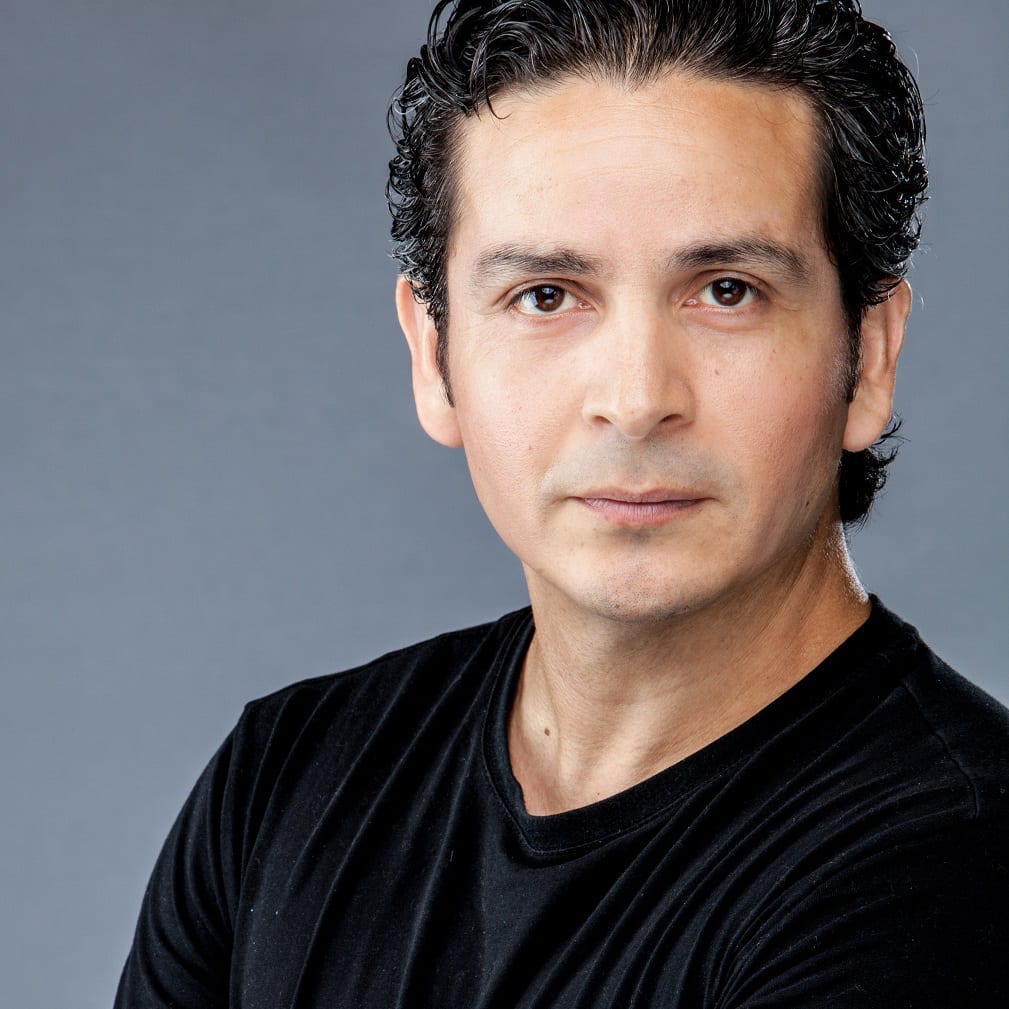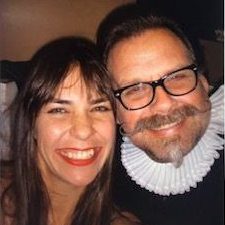
Donde van las Mariposas/A Fable from Mexico School Shows
Donde van las Mariposas/A Fable from Mexico is commissioned by The Bancroft Initiative and supported in part by an award from the National Endowment for the Arts. Donde van las Mariposas/A Fable from Mexico School Shows are sponsored by the Powell Foundation.
Recommended for Elementary Schools
ABOUT THE PROGRAM
Donde van las Mariposas/A Fable from Mexico, translating to “Where the Butterflies Go,” from Mexican-American choreographer Jimmy Orrante is based in Mexican culture and will explore environmental and cultural themes related to the migration of monarch butterflies as well as Día de los Muertos traditions. The production and educational curricula will be designed to grow young audiences’ understandings of diverse cultures and perspectives while providing an engaging introduction to the performing arts.
FEATURING: Ballet Austin TWO
CONCEPT & CHOREOGRAPHY: Jimmy Orrante
MUSIC: Pond5
BEHIND THE SCENES
Explore the music, drawings, and background information that inspired Donde van las Mariposas in the tabs below!
Donde van las Mariposas
A young woman, Helena, loves to spend time with her Abuela (grandmother) Emilia. The two of them spend hours together in Emilia’s garden and share a passion for nature. Helena is excited to join her friends and village community in the annual celebration of Día de los Muertos and the long-awaited butterfly migration. While there, she forms a new friendship with a boy in the village, Santos and together they enjoy the traditional dances, decorations and costumes, including special masks. Día de los Muertos and the migration hold unique significance as many believe that when the butterflies arrive, they carry the spirits of loved ones who have passed.
During the festivities, Emilia is visited by a surprise guest, a Spirit, who offers two premonitions – that Emilia herself will soon pass and become a spirit, and that the trees around the village will be cut down to make room for new houses. Even in her own sadness, Emilia worries that the removal of trees will disrupt the butterfly migration and break the community’s connection to the ancestral spirits. Before departing, the Spirit gifts her with some magic seeds. Emilia shares her experience with Helena and the magic seeds are placed in a box for safekeeping.
Before long, the Spirit’s predictions begin to come true. Trees are cut down and Emilia weakens and eventually dies. Helena grieves the loss of her dear Abuela but her heart lifts when she sees Emilia transformed into a butterfly. Knowing that the butterfly migration and the return of Emilia’s spirit cannot happen without trees, Santos reminds Helena of the magic seeds. They plant the seeds and soon the magic is revealed as trees quickly grow to replace those that were cut down. The whole village comes together once again, in celebration and anticipation of next year’s Día de los Muertos and return of the butterflies.
——-
Donde van las Mariposas
Una joven llamada Helena ama pasar tiempo con su Abuela Emilia. Las dos disfrutan de horas juntas en el jardín de Emilia y comparten el amor por la naturaleza. Helena está emocionada por unirse a sus amigos y a la comunidad del pueblo en la celebración del Día de los Muertos y la llegada tan esperada de las mariposas. Allí, forma una nueva amistad con un chico del pueblo llamado Santos, y juntos disfrutan de los bailes, las decoraciones y los trajes y disfraces, incluyendo máscaras especiales. Para muchos, el Día de los Muertos y la migración de las mariposas tienen un significado único porque creen que cuando llegan las mariposas, ellas traen los espíritus de sus seres queridos que han fallecido.
Durante las festividades, Emilia recibe un invitado sorpresa, un Espíritu, quien le ofrece dos premoniciones– que ella misma pronto fallecería y será un espíritu y que los árboles alrededor del pueblo serán talados para hacer espacio para nuevas casas. Aunque se siente triste, Emilia se preocupa de que si quitan los árboles, las mariposas no podrán migrar y la comunidad perderá su conexión con los espíritus ancestrales. Antes de irse, el Espíritu le regala unas semillas mágicas. Emilia comparte esto con Helena y guarda las semillas en una caja.
Poco después, las predicciones del Espíritu comienzan a hacerse realidad. Los árboles son talados y Emilia se pone débil y, al final, fallece. Helena se entristece por la pérdida de su querida Abuela, pero se alegra cuando ve a Emilia transformada en mariposa. Sabiendo que la migración de las mariposas y el regreso del espíritu de Emilia no pueden suceder sin árboles, Santos le recuerda a Helena que las semillas mágicas pueden ayudar. Ellos plantan las semillas y, rápidamente, la magia se revela y los árboles crecen para reemplazar a los que fueron cortados. Todo el pueblo se reúne de nuevo para celebrar y esperar el próximo Día de los Muertos y el regreso de las mariposas.
Click below to play some of the music from the eclectic soundtrack of Donde van las Mariposas.
These are some of the instruments you may hear in Donde van las Mariposas.
Maracas

Maracas are rattles that appear in many genres of Caribbean and Latin music. Usually played as a pair, they are shaken to make music.
Guitarrón Mexicano
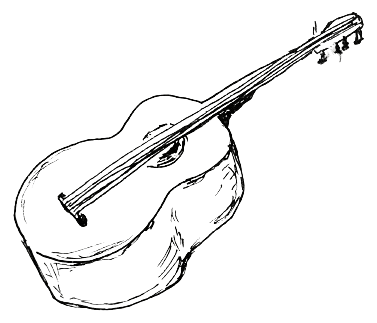
The guitarrón mexicano or Mexican guitarrón is a very large, deep-bodied Mexican six-string acoustic bass guitar played traditionally in Mariachi groups. Although similar to the guitar, it is not a derivative of that instrument, but was independently developed from the sixteenth-century Spanish bajo de uña. The guitarrón is used in Mexican Mariachi groups, which usually consist of violins, trumpets, guitar, vihuela (a high-pitched, five-string guitar-type instrument), and the guitarrón.
Spanish Guitar
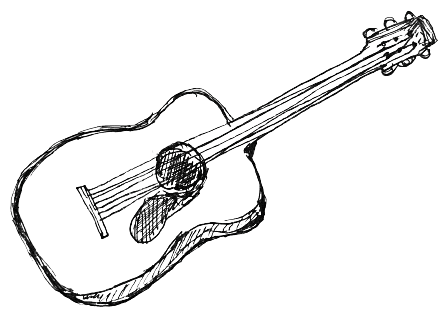
The Spanish guitar, also known as the classical guitar, is an acoustic wooden string instrument with strings made of gut or nylon, it is a precursor of the modern steel-string acoustic and electric guitars, both of which use metal strings.
Trumpet

The trumpet is a brass instrument, and the newest and most recent musical instrument introduced to the modern-day mariachi ensemble.
Original hand-drawn instrument sketches by Alexa Capareda
Costumes in Donde van las Mariposas are adapted from traditional Folklorico dresses of Mexico.
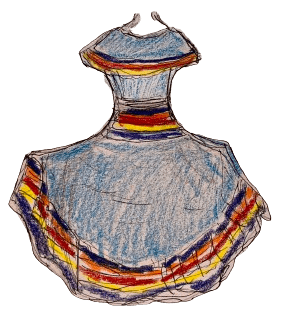
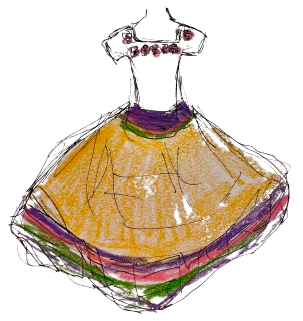
Original hand-drawn costume sketches by Alexa Capareda
Set Designs from Donde van las Mariposas by Indigo Rael.
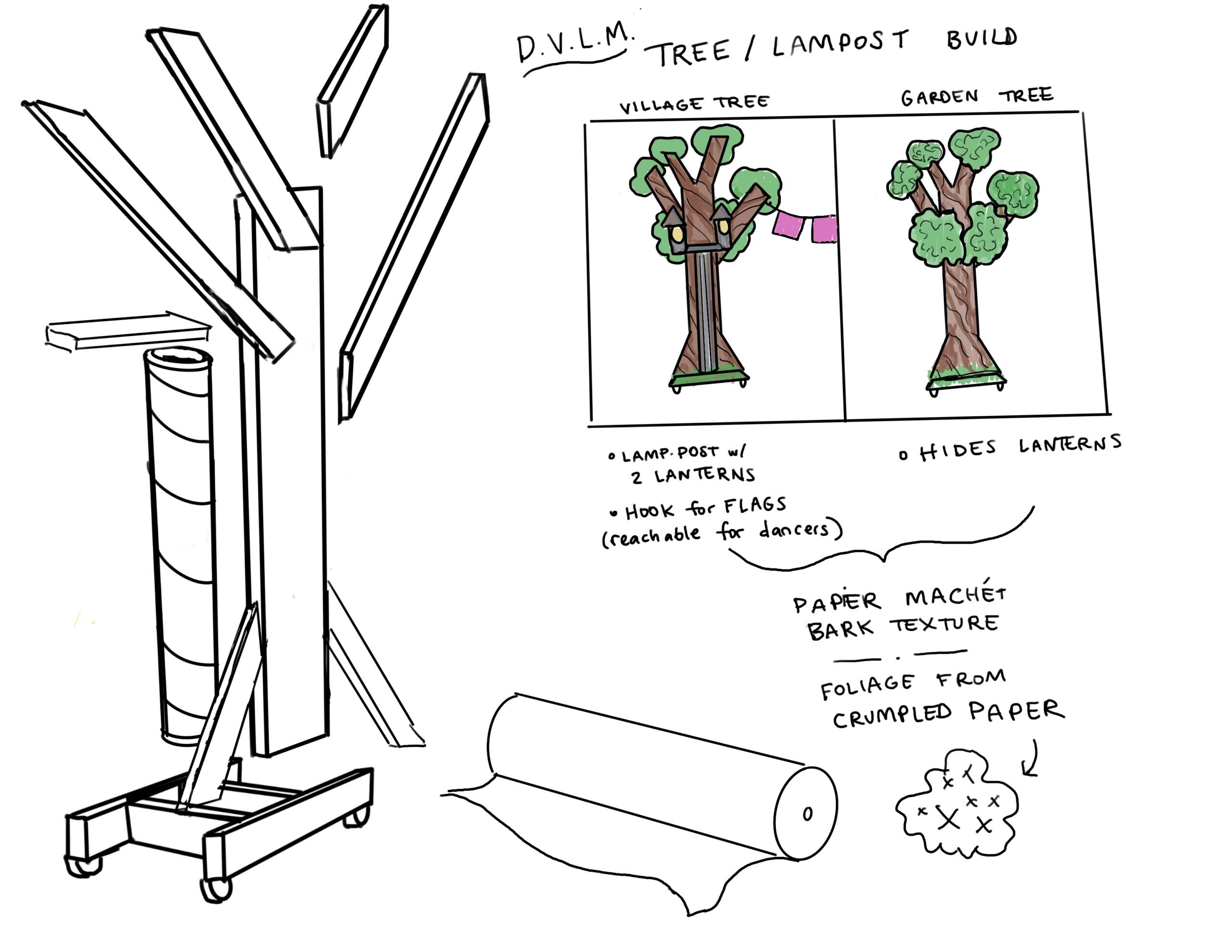
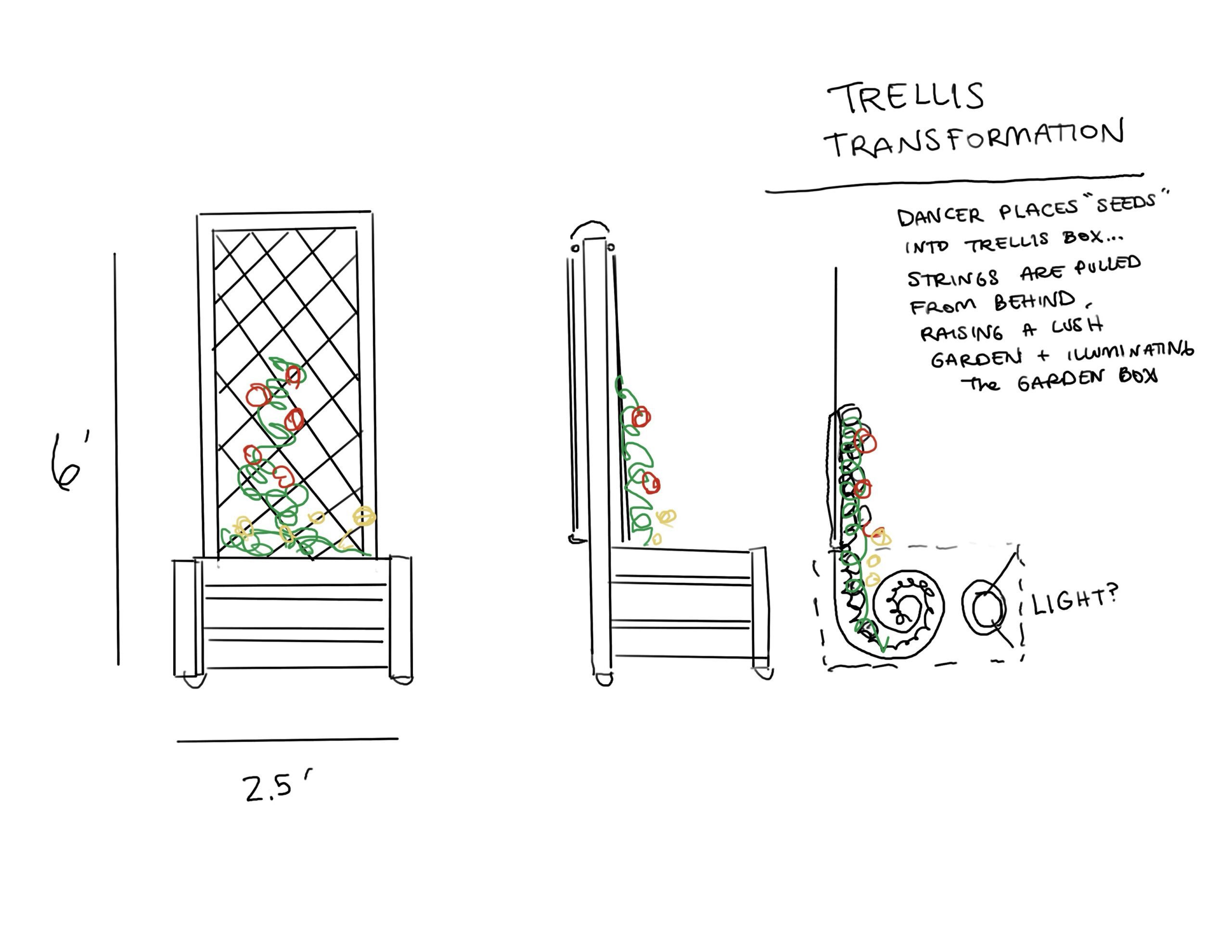
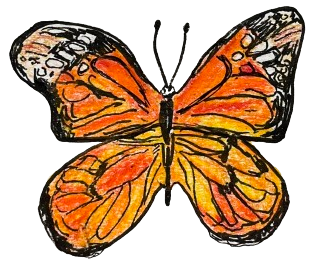
In Mexico, monarch butterflies are culturally significant and sacred to indigenous groups. The butterflies’ annual migration coincides with the Day of the Dead (Día de los Muertos), a traditional Mexican holiday that honors deceased loved ones. Indigenous peoples, including the Aztecs and the Purepecha, believe that the butterflies are the souls of their ancestors returning to Earth for the celebration. The butterflies are thought to bring the spirits of relatives to the living world for one night.
The butterflies’ arrival is often noted on November 2, which is also known as the Day of the Dead. During the two-day holiday, families gather to create altars, prepare traditional foods, and perform other rituals. The bright orange color of the monarch’s wings is said to match the orange of the cempasuchil flower, which is used to guide the ancestors to the altars with its strong fragrance.
Butterflies also symbolize transformation and renewal in Mexican culture and are sometimes seen as messengers between the living and the dead. The butterflies’ symbolic resonance has helped to motivate local and international communities to take action to protect the insect and nature in general.
Original artwork by Alexa Capareda
Texas is an important state in monarch migration because it is between the principal breeding grounds in the north and the overwintering areas in Mexico. Monarchs funnel through Texas both in the fall and the spring. During the fall, monarchs fly through Texas in a 300-mile-wide path stretching from Wichita Falls to Eagle Pass. By early November, most have passed through into Mexico. The second flyway is situated along the Texas coast and lasts roughly from the third week of October to the middle of November. Early each March, monarchs begin arriving from their winter grounds in Mexico. Seeking emerging milkweeds, they move through Texas laying eggs. Their offspring continue heading north, leaving most of Texas behind, the first of several new generations of monarchs that re-populate the eastern half of the United States and southern Canada.
CURRICULUM
The Donde van las Mariposas/A Fable from Mexico curriculum is offered at no charge, and includes the following components:
- Ballet Folklorico Dance Lessons choregraphed and taught by Chuy Chacon, Artistic Director of Roy Lozano’s Ballet Folklorico de Texas
- Butterfly Yoga Flows
- Butterfly Meditation Mindfulness Activities
- Social Studies Lessons in Cultures and Traditions with a focus on Dia de los Muertos
- Science Lessons on Butterflies and their Migration
The curricula are optional and may be implemented pre-show or post-show.
VIDEO GALLERY
Questions?
If you have any questions that are not answered on this page, please contact Associate Director of Education, Kathleen Rockefeller, by email.


This project is supported in part by the National Endowment for the Arts.
Ballet Austin TWO is endowed by Sarah & Ernest Butler through the Ballet Austin Foundation.
POWELL FOUNDATION
Education Underwriter


